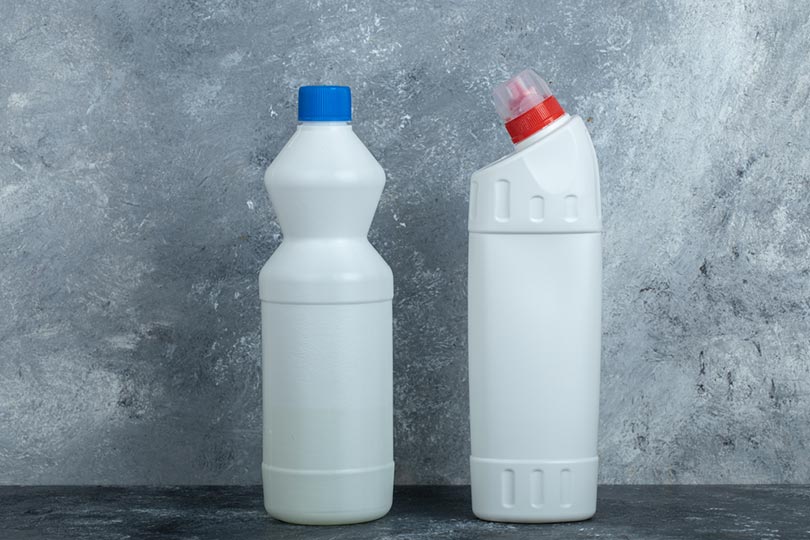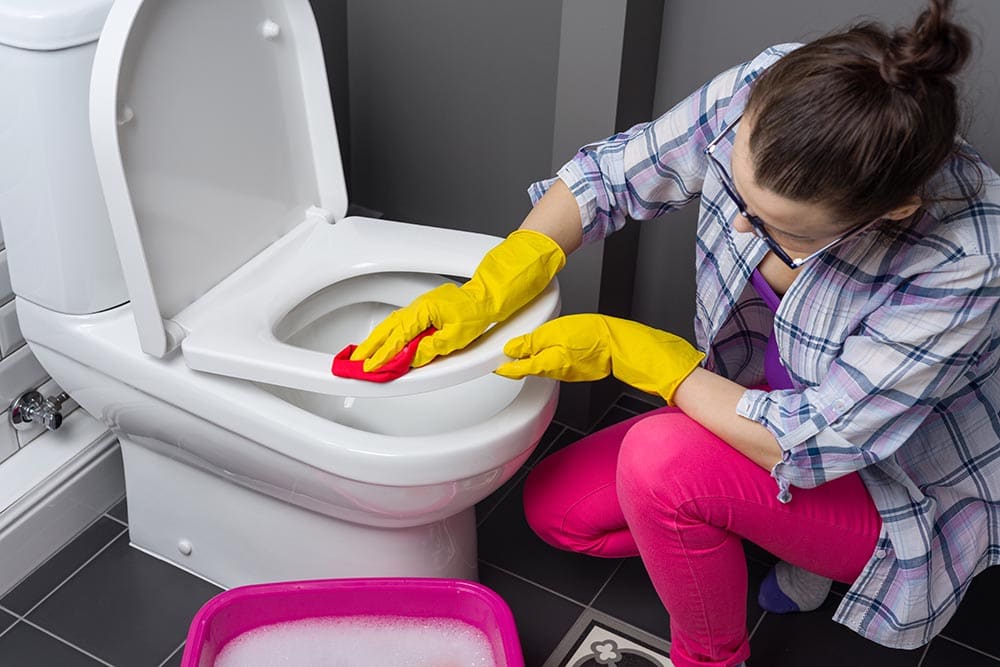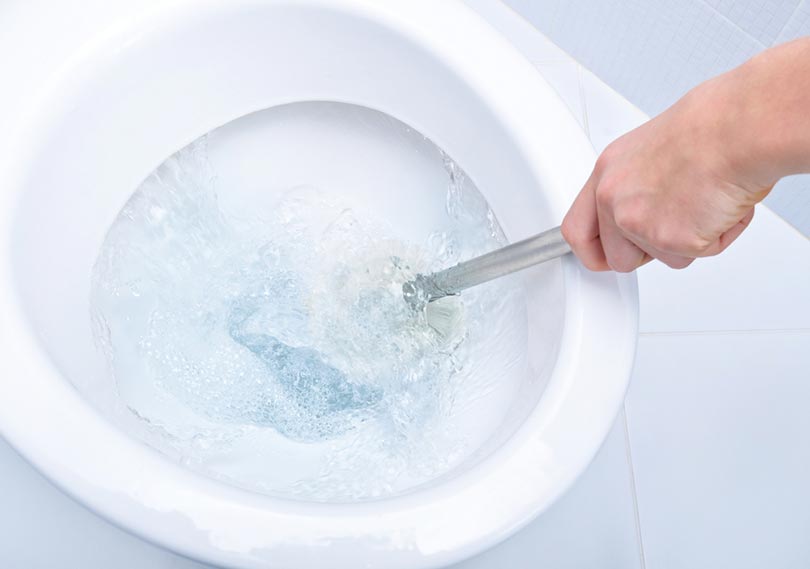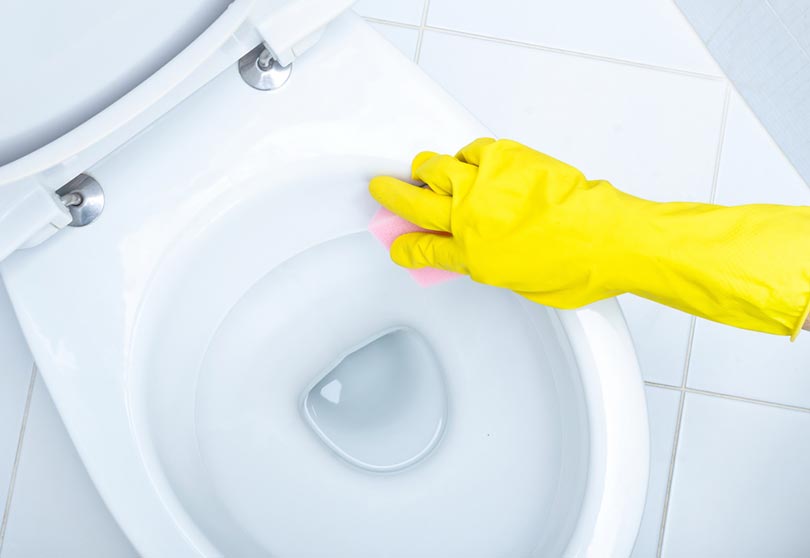Can You Clean a Toilet With Bleach? 3 Simple Steps
-

- Last updated:

Cleaning the toilet is one of the worst home cleaning jobs there is, and it’s one that many people shirk away from until there are visible signs of staining and dirt. However, it is one area that has the potential for the most bacteria and mess.
It is possible to clean a toilet bowl using bleach, although you should always take care to avoid mixing bleach with any existing ammonia cleaners, and you should never put bleach in the toilet tank because it can corrode the working parts of the toilet.
Commercial bleach and toilet cleaning products not only contain sodium hypochlorite or bleach, but they also contain thickening agents. These ingredients thicken the liquid so that it remains on the porcelain longer, enabling the cleaner to get rid of dirt. Although bleach is the most commonly used toilet cleaning product, there are other solutions. Vinegar is an effective disinfectant and can do a better job of removing stains than bleach.
The 3 Steps on How to Clean Your Toilet Using Bleach
When using bleach, even in diluted form, it is recommended that you open a window. You should also wear gloves when cleaning the toilet.

1. Dilute the Bleach
It is recommended that you dilute bleach before using it to clean toilets, sinks, and other items. The recommended dilution is 2½ tablespoons of bleach to 1 gallon of water. You’re unlikely to use a full gallon of water when cleaning a toilet, so adjust the measurements accordingly. Ten milliliters of bleach mixed with 250 milliliters of water in a spray bottle should be ample to clean the bathroom. When using a spray bottle, ensure that you don’t use one that has previously contained ammonia because the mixture of ammonia and bleach can create harmful gases.
2. Flush and Clean
Flush the toilet and then spray the inside of the bowl as well as inside the rim. Spray the underside of the toilet seat, too, before scrubbing the sprayed areas.
3. Rinse
Once you have sprayed and scrubbed the areas, rinse them down with clean water to remove the bleach and any lingering dirt.

Alternatives to Bleach
Not everybody likes to use bleach. Some find its strong smell to be too overpowering, while others may suffer chlorine intolerance or even bleach allergies. Fortunately, some alternatives can be used to clean the toilet.
Ammonia-based cleaners can break down the grease and dirt and act as an effective alternative to bleach chemicals. However, you should never combine the two.
Another alternative is to create your own toilet cleaner using products that most people have in their kitchen cupboards or that are easily sourced from stores. White vinegar can make a powerful cleaning agent. You can safely use it at full strength, if you want, or dilute it with water to achieve the desired solution.
White vinegar can do a good job of removing stains, too, but to do this it needs to stay in contact with the bowl and the liquid consistency of vinegar means that it naturally runs off. Make a paste consisting of white vinegar and borax, which is another good and sympathetic cleaner. Rub the paste on the affected areas, leave it for two hours, and then clean the paste off to remove stains and dirt.
Don’t Put Bleach in the Tank
Although diluted bleach is considered safe for cleaning the bowl and porcelain components of a toilet, it is not safe for use in the tank. The tank contains a host of working parts, some of which can be corroded if they come into contact with bleach. White vinegar is a better alternative in the tank. It cleans, removes stains, and does cause corrosion.

Don’t Mix Ammonia and Bleach
Ammonia-based cleaning products are a popular alternative to bleach cleaners. However, if you have used ammonia cleaning products, you should eschew the use of bleach. Combining these two products causes chloramine gas to form. Chloramines can cause coughing and may lead to serious respiratory problems. If you have accidentally combined these two, you should get out of the room and allow plenty of time for the gases to dissipate before re-entering.
In Conclusion
The toilet harbors a host of bacteria and can become dirty and stained. Bleach is an effective way to clean the toilet and when used at a suitable rate of dilution, it is safe for most people. Cleaning does require some scrubbing, and bleach will not do as effective a job of removing stains as a solution as simple as white vinegar, but it does kill bacteria and disinfects the toilet.
Dilute the bleach, put it in a spray bottle, and clean the porcelain areas of the toilet, before rinsing the surfaces down with clean water. Do not mix bleach and ammonia, and don’t put bleach in the tank or it could corrode the flush and other working components.
Featured Image Credit: azerbaijan_stockers, Shutterstock
Contents

